Resources
Parker Fulflo EcoBond Cartridges - High Purity Filtration
Submitted by Parker

Fulflo EcoBond™ Cartridges are available in nominal ratings of 1µm, 5µm, 10µm, 25 µm and 50µm
Benefits
- Thermally bonded melt blown fiber matrix provides dimensionally stable construction
- Continuous fiber matrix prevents media migration and ensures consistent quality filtration performance
- Finish-free construction provides optimum fluid purity and eliminates foaming condition
- Superior inter-layer bonding eliminates contaminant unloading and channeling
- FDA grade polypropylene (DOE only) certified to ANSI/NSF61 standard for contact with drinking water components
- Narrow range fiber size optimizes consistency of filtration performance
- Polypropylene construction provides broad chemical compatibility for a variety of applications
- All materials of construction are FDA listed as acceptable for potable and edible liquid contact according to CFR Title 21
- Single component construction simplifies compatibility options and provides easy disposal
Applications
- Photographic Chemicals
- DI Water
- Plating Solutions
- R.O. Prefiltration
- Membrane Prefiltration
- Organic Solvents
- Oilfield Fluids
- Bleach
- Potable Water
- Chemical Processing Fluids
Contact Valin today to get more information about these products at (855) 737-4717, or submit your question to our experts here.
A lesson for me is that I need to involve you earlier in the program.
You were tireless in your support and it will not be forgotten!
Latest from Valin's Blog
The NIST Chemistry WebBook contains a great deal of information regarding the properties of a broad range of chemicals and is helpful for those who deal with chemical processes.In this article, Jon Monsen has outlined the procedure for finding the actual density of a gas using the WebBook.
